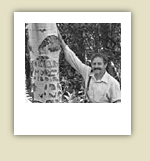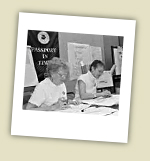Timeframes - Who Does What When?
The very first step is to decide on a project and a date and get the responsible official’s approval. That is up to you. Then you’re ready to submit a proposal. You may submit your project as far in advance as you wish. The minimum is four (4) months prior to the start of your project. This allows for the following requirements:
- Volunteers have 6 weeks to prepare for a project, once accepted.
- Project Leaders have 2 weeks to make volunteer selections (with a five day grace period to arrange for alternates if necessary.)
- A project is posted on passportintime.com for a minimum of 6 weeks.
|top|
Timetable of tasks before, during, and after a PIT Project
WHO |
WHAT |
WHEN |
Project Leader |
Submit PIT Project proposal on-line |
16
weeks before start date |
Clearinghouse |
Download proposal and send word document version for filing and review to- Project Leader (with project-specific timeline)
Agency PIT Coordinator
|
16
weeks |
Agency PIT Coordinator |
Approve project proposal (optional): (Changes must be submitted to Clearinghouse within 24 hours) |
16
weeks |
Clearinghouse |
Post PIT project on passportintime.com |
16 weeks |
Volunteers |
Applications due to Clearinghouse |
9
weeks |
Clearinghouse |
Forward applications to project leader |
9
weeks |
Project Leader |
Notify Clearinghouse of selections/non-selections |
6 weeeks minimum
(8 weeks maximum) |
Project Leader |
Notify selected volunteers |
6 weeeks minimum
(8 weeks maximum) |
Clearinghouse |
Notify non-selected wolunteers |
6 weeeks minimum
(8 weeks maximum) |
|
Happy volunteers arrive! |
Start date |
Project Leader |
Fill out your volunteers' passports and present them |
Last day |
Project Leader |
Give your volunteers the critique form and collect them to send to the Clearinghouse |
Last day |
Project Leader |
Provide a list of VIPs to whom the volunteers may write letters about their experience. This may include agency leaders and members of Congress |
Lasy Day |
|
Exhausted volunteers leave. |
End date |
Project Leader |
Send your volunteers' hours to the Clearinghouse |
1 month after end date |
Project Leader |
Send a project summary to the Clearinghouse |
2 months |
|top|
Submitting a PIT Project Proposal
For Forest Service PIT Leaders, please submit your proposals on-line at the Forest Service Proposal
Submission page. For all other PIT Partner Agency Leaders (BLM, State Parks, and others) please submit your proposals, and make your payment on Paypal, at the PIT Partner Proposal Submission page.
When you submit your proposal, you will get a response from the Clearinghouse within 3-5 business days (sometimes sooner) that includes:
- A word document of your proposal for your files,
- The due date by which volunteers must apply for your project to the Clearinghouse.
- The date the Clearinghouse will send you the applications for your project.
- The date by which you must notify the Clearinghouse of your volunteer selections
- When you will receive your project materials (passports, pins, patches, etc.)
|top|
Current Fiscal Year Schedule for Submitting PIT Project Proposals - submit your proposal as soon as possible and we will work with you.
Filling out the PIT on-line Proposal Form
State: List
the state in which the project will take place.
Unit/Forest: List
the name of the organization or agency hosting the project.
Project
Name: The title should give some hint of what the project is about. Indicate if it is a survey, excavation, restoration, etc. Use site names rather than numbers. If a project has run for a number of years, indicate the number in sequence using Roman numerals. Please be brief and creative.
Project
Dates: Include only the days that volunteers will be working. If work begins Monday morning, that is your start date. You can specify they need to show up the night before in the detailed information you send to your selected volunteers. If your start and end dates include a weekend, confirm that with "includes weekend(s)."
Time
Commitment: Pull-down menu has these options: Must commit to full session. Must commit to full session, may participate in both (all, etc). Must commit to _ days.
Project
Description: Include general location, historical information about the site, time period and what is known or not known about the site or area, past work in the area, and what type of work the volunteers will do. Include other information if appropriate, e.g. field trips, presentations by other specialists, after-work attractions in the area, etc.
If you have a recent or historic photograph to add to your project posting on the web, email it to the Clearinghouse after you have submitted the project proposal. (optional)
Number
of openings: Include only those you want through the Clearinghouse. If you have 10 individuals you've already promised, those are in addition to what you advertise through the Clearinghouse. Example: You want 20 volunteers; you plan to engage 10 individuals from the local historical society; you would put "10" in the "number of openings" on the proposal form to be recruited through the Clearinghouse.
Special
skills: There are two options here: special skills, abilities or experience the volunteer "must" have and those taht would be "helpful, but not required". If your project is physically demanding, please note "volunteers must be physically fit and able to..."
Minimum
age: Federal law requires that children under the age of 18 be accompanied by a responsible adult. The pull-down menu options are:
- 18 years old (this means you accept only adults)
- __ years old with a responsible adult (you set the minimum)
- Under 18 with a responsible adult (you accept children of any age)
Facilities:
Indicate where the volunteers will/may stay; hotels, FS barracks, camping. If FS housing is offered, how many will it sleep? For camping, indicate free or fee and what amenities if any are available (Toilets? Shower? Potable water? RV hook-ups?) If they are staying in hotels/motels, simply state what town and indicate if that town, or nearby towns are "full service" (hotels, motels, restaurants, gas stations, banks, grocery stores, etc).
Nearest
towns: List the town closest to the project first,
then one or two others nearby. If the project is
in town, list the town again under “nearest
town” and select “0” miles.
Applications
due: Leave blank. The Clearinghouse assigns the application due date.
Approval: Proposals will not be accepted without the signature of a responsible official. Please include contact information for officer, etc in Clearinghouse email.
|top|
Selecting Your Volunteers
- Do not pre-select volunteers. All volunteers who apply by the application due date, have a right to be considered. This is why the Clearinghouse only sends you the applications after the application due date.
- If your project on the web says you have 8 openings, then that is the minimum you can select from the Clearinghouse applications. You can always select more, but not fewer. In other words, if you say you have 8 openings and you received 8 applicants, unless you have documented a compelling reason not to select one of those, you must select all 8.
- You must notify the Clearinghouse within 3 weeks of your project's application due date of those you have selected and those you have not. Put this on your calendar! If you will be out of the office, make arrangements to do this remotely or have someone else do it for you!
- When you contact the Clearinghouse with your list of volunteers, include those you recruited locally so the Clearinghouse can add them to the database and send passports in their names.
- You must contact your selected volunteers within 3 weeks of your project's application due date. If you fail to do so, they call the Clearinghouse to ask if they've been accepted. Remember, volunteers have to plan time off work, transportation, etc. This is a big deal to them. We need to let them know their status in a timely manner.
- The Clearinghouse will contact those volunteers you do not select. You only need to contact those you select and provide them project details as needed.
- You may extend an application deadline if you do not receive enough applicants by the posted deadline. Simply call the Clearinghouse and ask them to extend the date on the web. However, if you do so, remember:
- By extending a due date, you are in essence saying that you have accepted all those who applied by the original date. Unless you have documented a compelling reason not to select someone who applied by the original date, you must accept all who did.
- Those who applied by the original deadline are still expecting to hear from you within 3 weeks of that date, so call those who applied and let them know their status.
- The Clearinghouse tries very hard to impress upon volunteers that when they apply and are accepted, they have a responsibility to call the project leader if they have to cancel. You should emphasize this as well when you initially contact your volunteers. It is very frustrating to plan for 10 volunteers and have only 5 show up, and of course, it's unfair to any who got turned away because the project was full.
- As the time draws near for your project, remember to send your volunteers anything they will need to prepare. Provide the usual list of provisions like camping gear, good shoes, and bug spray, and don't forget GOOD DIRECTIONS! Many of these folks will be new to the woods - don't assume they know all about dirt roads.
Cancelling a Project
First, remember guidelines #11 and #12. You may cancel a project for reasons that would put the volunteers in danger (fire, flood, etc), but not because you don't have money or you transferred to another job. The responsible official's signature on your proposal is a promise that the unit will support this project. If the responsible official chooses to cancel a project or you do have a situation that would put your volunteers in danger, these are the steps to follow:
- Notify the Clearinghouse immediately of the cancellation.
- If the project has already closed and you have selected your volunteers, the responsible official should personally contact the volunteers and explain the cancellation.
- If the project has not yet closed, request the names of volunteers who have applied to date and have the responsible official personally contact those volunteers to explain the cancellation.
Notify the Clearinghouse when you have contacted all volunteers and they will make sure those volunteers have a list of projects still open.
|top|
After Your Project
- Contact the Clearinghouse within one month of the completion of your project with your list of volunteers by name and the hours they contributed. The Clearinghouse will update the database and credit your volunteers and your unit and project.
- If you have "walk-ons" or unexpected volunteers who show up and you are able to let them be involved, you can add their names and contact information to the list you send the Clearinghouse and they will add them to your project database.
- The Clearinghouse posts a "volunteer honor roll" on the website with volunteers' names who have contributed 500 hours or more. The volunteers know how many hours they've contributed. If you don't send in their hours, the Clearinghouse can't credit them. If their name is not on the honor roll, the Clearinghouse hears about it!
- Send the Clearinghouse a project summary suitable for posting on passportintime.com. This need not be long or detailed. If you have analysis results, summarize them. You may also send summaries that are more human interest - where the volunteers were from, funny things that happened, etc. Volunteers may also submit stories and project summaries.
|top| |
|





